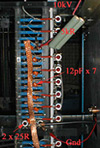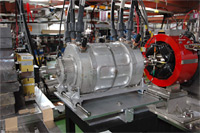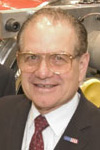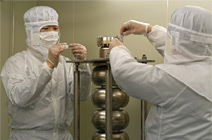 |
|
|
 |
Europe Defines a Strategy Plan for the Future of Particle Physics

(L-R) Torsten Åkesson, Enzo Iarocci, Guy Wormser and Ken Peach |
Last week, the future of particle physics in Europe was debated in Orsay (near Paris, France) from 30 January to 1 February. An Open Symposium, organised by the CERN Council Strategy Group, gathered more than 400 scientists from all over Europe, as well as representatives from North America and Asia. With the help of an interactive webcast, 70 scientists participated remotely. A lively discussion took place which will provide input for the final strategy to be selected by July. Before this meeting, each country was invited to submit its roadmap. Suggestions from organisation representatives and from groups of scientists or individual physicists were also welcomed. "They have been asked what their priorities were.", said Ken Peach, co-chair of the Strategy Group and Chair of the CERN Scientific Policy Committee. "This open symposium has been created to give the opportunity to physicists to intervene and share their opinions. We were convinced that half of our time should be spent in discussions."
Read more...
Conference slides
CERN Council Strategy Group website
Symposium photo gallery
-- Perrine Royole-Degieux
|
 |
|
|
 |
|
Upcoming meetings, conferences, workshops
LLRF Hardware Development Workshop (doc)
FNAL
9-10 February, 2006
RDR Meeting
FNAL
13-14 February, 2006
Agenda (pdf) EUDET Kick-Off Meeting
DESY
15-17 February 2006
ILC GDE Meeting
Bangalore, India
9-11 March 2006
LCWS 2006
Bangalore, India
9-13 March 2006
International Symposium on Detector Development in Particle and Astroparticle Physics and Synchrotron Radiation
SLAC
3-6 April 2006
NSF/DOE Review
ILC - Americas
FNAL
4-6 April 2006
ILC Software and Physics Meeting
Cambridge
4-6 April 2006
International Accelerator School for Linear Colliders
Sokendai, Graduate School for Advanced Studies
Hayama, Japan
19-27 May 2006
CALOR 2006
12th International Conference on Calorimetry in High Energy Physics
Chicago, USA
5-9 June 2006
ALCPG Meeting
Vancouver, Canada
19-23 July 2006
ILC GDE Meeting
Vancouver, Canada
19-23 July 2006
|
|
 |
 |
|
|
 |
TRIUMF Kicker Group
Experiments with
6 Nanosecond Pulses

Prototype PSI kicker stack adapted for ILC kicker "proof of principle” test bed. |
The rise and fall times of the pulses in the injection kickers influence the minimum circumference of the damping rings in the International Linear Collider. The Baseline Configuration Document features 6 km rings which will require pulsers to feed 50 ohm stripline kickers. The 5 kV (kilovolt) pulses must have 6 ns (nanosecond) rise and fall times, and a total duration of approximately 14 ns. Operating in a burst mode, every 5 seconds the kicker will have a 3 MHz (megahertz) burst that lasts 1 ms (millisecond). The combination of the electric component from the 5 kV voltage pulse and the magnetic component from the accompanying 100 A (amp) current pulse will deflect the electron and positron beams. The temporal specification of the kicker pulse presents a challenge to the existing generation of pulser technology.
Previously, the TRIUMF kicker group designed and built a kicker for the Paul Scherrer Institute (PSI) with deflection voltages up to 25 kV at 75 kHz (kilohertz) continuous wave and with 40 ns rise and fall times. Each of the 4 modulators in the PSI kicker consists of two stacks of 17 series 1 kV Field Effect Transistors (FET): the present design of the MOSFET card (fig 1) allows a FET to collapse almost 1 kV in approximately 3 ns. This does not translate however to fast switching times for a stack of FETs when combined in the conventional manner.
Read more...
-- Shane Koscielniak, TRIUMF |
 |
|
|
 |
From Injection Systems to Kickers, KEK and SLAC Successfully Collaborate on ATF

The kicker magnet that SLAC supplied for the ATF at KEK. |
Last November, a team of accelerator physicists from KEK and SLAC succeeded in extracting three bunches of electron beam each spaced by 154 nanoseconds from the storage ring in the Accelerator Test Facility (ATF) in Japan. (See ILC NewsLine, 10 November 2005) Using a "kicker magnet" with a pulse length of 310 nanoseconds, developed by SLAC, this important accomplishment delivered an ILC-like beam for the first time.
Read more...
-- Elizabeth Clements
|
 |
|
|
 |
From Fermilab Today
7 February 2006
DOE FY07 Budget Request Has $775 Million for HEP
The President's Budget Request for FY07 is only the beginning of the process for the Department of Energy, but the numbers were cause for cautious optimism by Fermilab Director Pier Oddone on Monday. "We're happy with the increase in the budget request for high energy physics," Oddone said.
Read more...
From CERN
1 February 2006
European particle physics sets course for the future
Orsay, 1 February 2006. "Particle physics has an exciting future" : this was the key message emerging from the Open Symposium on particle physics strategy in Europe, which concluded at Orsay, France, today.
Read more...
|
|
 |
 |
|
|
 |
U.S. Budget News
In last week's column on the role of the GDE R&D Board (RDB), I made the statement that "the continuing and future R&D programs will be absolutely crucial for demonstrating critical elements of the design, optimizing it with respect to cost and performance, and finally evolving it as technologies improve, so that we can build the best possible machine when the ILC is constructed."

Ray Orbach |
I will expand on that statement today, especially in light of the good budget news from the U.S. The President's 2007 budget request to Congress includes a doubling of the ILC R&D budget from $30M to $60M. This is good news, indeed! Of course, this is just the beginning of the budget process in the U.S. and we will need to be equally successful in Congress when they act on the budgets later this year. (See today's In the News feature, "DOE FY07 Budget Request Has $775 Million for HEP" and slide 29 in the presentation given by Ray Orbach, Director of the Office of Science.)
The worldwide linear collider community has been focused on developing a global design for the ILC, ever since the choice was made to base the main linac on superconducting RF technology. To that end, ICFA created the GDE, and we are now almost six months old. During those six months much of our focus has been on determining a baseline configuration for the ILC. We recently accomplished that goal and documented it in our Baseline Configuration Document (BCD).
Much of our emphasis has now transferred toward organizing the design and costing effort, with a goal of producing a reference design by the end of 2006.
Read more...
--Barry Barish
Director's Corner Archive
|
 |
|
|
 |
|
Registration for Bangalore Workshop
There has been some confusion about registering for the GDE meeting in Bangalore. If you are attending the GDE meeting, you must also register for the LCWS. All food, shuttles and other services are covered by the registration fee for the LCWS. If you have any questions about registration, please contact Maxine Hronek.
ILC Related Preprints
hep-ph/0602035
5 Feb 2006
Flavor Changing Neutral Currents involving Heavy Quarks with Four Generations
hep-ph/0602030
2 Feb 2006
Virtual Corrections to Bremsstrahlung in High-Energy Collider Physics: LHC and e+ e- Colliders
hep-ph/0602022
2 Feb 2006
Using Invisible Graviton Radiation to Detect Heavy Electroweak Resonances at a 500 GeV e+e- Collider
hep-ph/0601217
26 Jan 2006
ILC: Physics Scenarios |
|

Fumio Furuta, KEK, and Hyong Suk KIM, Kyungpook National University, prepare a 9-cell ICHIRO cavity for high gradient field test in the clean room of STF, KEK.
|
|

